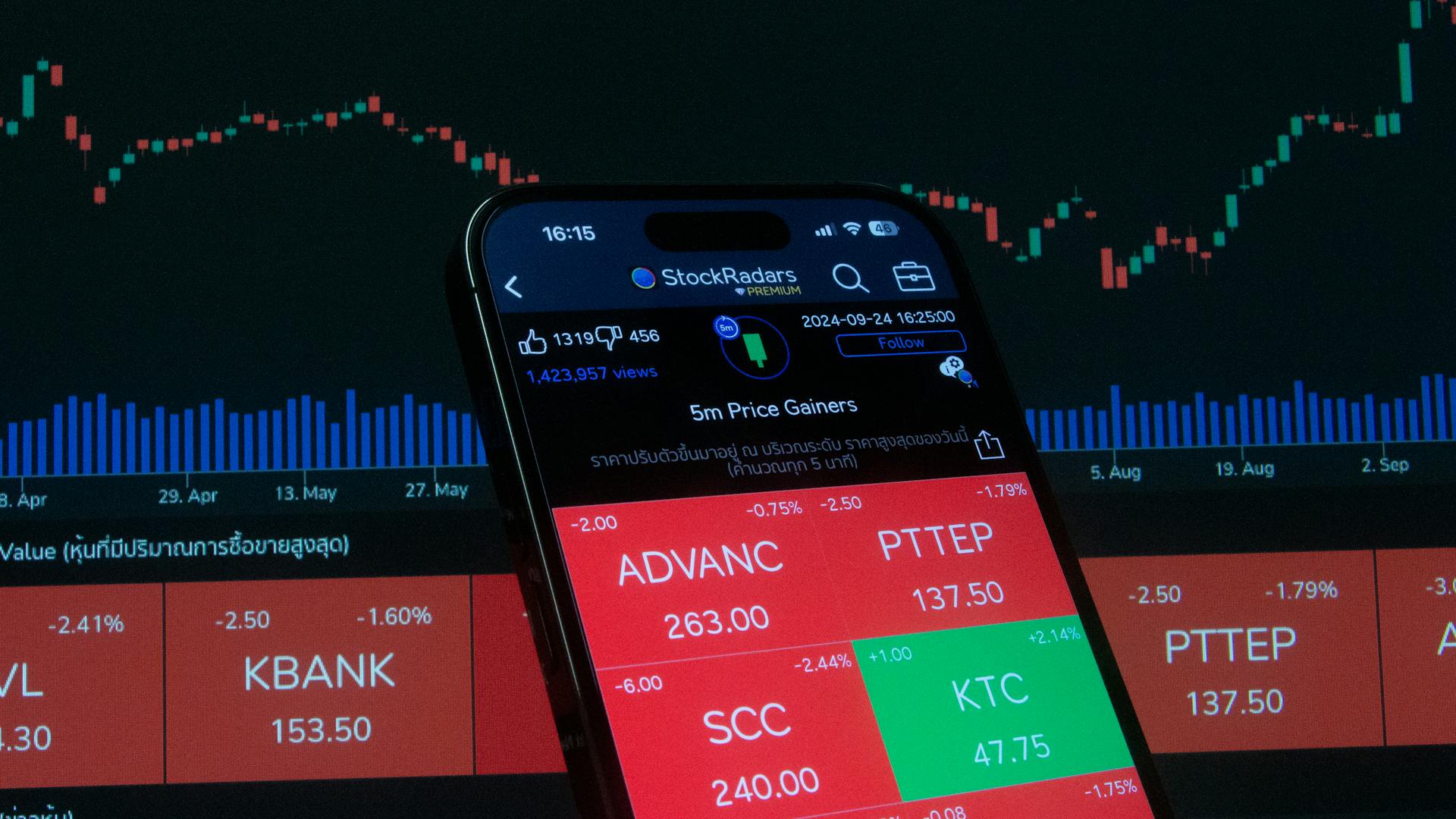
Share prices can change rapidly, often leaving investors wondering what's behind the fluctuations. A key factor is investment analysis, which involves evaluating a company's financial health, growth prospects, and competitive position.
Investment analysts use various tools and techniques to assess a company's value, such as analyzing its income statement, balance sheet, and cash flow statement. This analysis helps investors make informed decisions about whether to buy or sell shares.
Market sentiment also plays a significant role in determining share prices. As investors' attitudes and emotions towards a company or industry change, so do their buying and selling decisions, influencing the overall market trend.
Investors' perceptions of a company's potential for growth, profitability, and risk can shift quickly, causing share prices to adjust accordingly.
Readers also liked: 3m Company Stock Splits
Market Forces
Market forces play a significant role in determining share prices. The law of supply and demand is the driving force behind stock prices, with billions of shares being bought and sold each day.
Supply and demand are constantly fluctuating, causing stock prices to go up and down. Imagine there are 1,000 people willing to buy one share of stock XYZ for $10, but there are only 500 people willing to sell one share of XYZ for $10. This imbalance leads to a higher offer price, which persuades some owners to sell at $10.50.
The stock market operates like an auction, with sellers representing the supply side and buyers representing the demand side. Sellers have two options: setting an asking price or accepting bids. When dealing with asking price, the seller sets a price that a buyer matches, and the exchange executes the trade. If everyone is trying to sell, the market floods stocks, and sellers begin to accept lower prices to limit their losses.
The market can be affected by various factors, including market sentiment toward a stock, industry, or the overall market. If investors are confident in a company's prospects or the potential for positive developments, they are more likely to want the stock. Conversely, a loss of confidence can lead investors to sell, pushing down the stock price.
Here are some key factors that can affect sentiment toward a stock:
- Quarterly earnings reports beating or falling short of expectations
- Analyst upgrades or downgrades
- Positive or negative business developments
Supply and Demand
Supply and Demand is the driving force behind stock prices. It's like an auction, where sellers represent the supply side and buyers are the demand. When dealing with asking price, the seller sets an asking price for the stock which a buyer matches, then the exchange executes the trade, and finally the stocks change hands.
Sellers have two options: setting an asking price and accepting bids. When dealing with asking price, the seller sets an asking price for the stock which a buyer matches, then the exchange executes the trade, and finally the stocks change hands. If everyone is trying to sell, the market floods stocks, and sellers begin to accept lower prices to limit their losses.
The stock market is not that complicated, and it operates like an auction. The sellers represent the supply side while the buyers are the demand. The more potential buyers join the bid, the demand goes up, and so does the price.
Take a look at this: Stock Exchange
Companies have various mechanisms for stabilizing their stock prices. When the supply is greater than the demand, the stock prices can hit rock-bottom. To prevent this, the company buys back some of its shares at the market price, a process known as delisting.
Here's a breakdown of how supply and demand affects stock prices:
- High demand leads to higher stock prices.
- Low demand leads to lower stock prices.
- Excess supply can lead to lower stock prices.
- Excess demand can lead to higher stock prices.
The current stock price is nothing more than the price at which the last transaction took place. For many stocks, transactions are occurring every second the stock market is open.
Inflation
Inflation has a significant impact on the market, driving valuations in a particular way. Historically, low inflation has been associated with high multiples.
Deflation, on the other hand, is generally bad for stocks. It signifies a loss in pricing power for companies.
Low inflation drives high multiples, making it a crucial factor to consider.
If this caught your attention, see: Stocks Trading at 52 Week Low
Substitutes
Companies compete for investment dollars with other asset classes on a global stage, including corporate bonds and government bonds. This competition plays a significant role in the demand for U.S. equities.
The relationship between demand for U.S. equities and their substitutes is hard to figure, but it's crucial to understand. The substitutes include commodities, real estate, and foreign equities, all of which can attract investment dollars away from U.S. equities.
Curious to learn more? Check out: Sentinelone Stock Symbol
Investment Analysis
Investment analysis is a crucial part of understanding why share prices change. Analysts use data from financial statements to calculate a company's competitive advantage and financial health.
Professionals mostly do stock market analyses, using data like price-to-earnings ratio, return on equity, and earnings per share to determine the attractiveness of an asset.
These calculations help identify securities worth investing in, and allow investors to make informed decisions. You can do all this with the help of analysis tools like average directional index, on-balance volume, and the stochastic oscillator.
Fundamental factors like earnings per share (EPS) and valuation multiple (P/E ratio) are the primary drivers of stock prices in an efficient market. Earnings per share is the owner's return on their investment, and the valuation multiple represents the price you're willing to pay for the future stream of earnings.
The valuation multiple is a way of representing the discounted present value of the anticipated future earnings stream. This stream of earnings may be distributed as dividends or retained by the company for reinvestment.
Here are the key factors to consider in investment analysis:
- Earnings per share (EPS)
- Valuation multiple (P/E ratio)
- Price-to-earnings ratio
- Return on equity
- Earnings per share growth
Market Dynamics
Market dynamics play a significant role in determining share prices. Research suggests that economic and market factors account for 90 percent of a stock's movement.
Stock prices are influenced by the law of supply and demand, where billions of shares are bought and sold each day. This buying and selling activity sets stock prices, with the price being determined by what current buyers are willing to pay and what current sellers are willing to take.
Gross Domestic Product (GDP) is a key economic indicator that affects stock prices. A high GDP, typically above 3%, creates jobs and boosts stock prices, while a low GDP has the opposite effect.
Here are some key economic data investors look at to predict future market conditions:
- Gross Domestic Product (GDP)
- Unemployment rate
- Inflation and Deflation
- Interest rates
These factors can significantly impact stock prices, making it essential to stay informed about market dynamics.
Market Sentiment
Market sentiment is a tricky thing, often influenced by the psychology of market participants. This can lead to biased and obstinate behavior, making it difficult to predict stock prices.
Market sentiment is being explored by the relatively new field of behavioral finance, which suggests that markets are not always efficient and that psychology and social science disciplines can explain this inefficiency.
Investors tend to overemphasize data that comes easily to mind, and many react with greater pain to losses than with pleasure to equivalent gains. This can lead to persistent mistakes in investing.
The field of behavioral finance confirms observable suspicions, and some investors claim to be able to capitalize on this theory. However, for most, behavioral finance remains a new and somewhat mysterious category.
Market sentiment can be influenced by a single piece of news, causing a stock's price to be artificially high or low. This can make it difficult for investors to make informed decisions.
The market is a voting machine, where the price of a stock reflects what current buyers are willing to pay and what current sellers are willing to take. This is determined by supply and demand, just like any commodity.
Investors should be aware of the power of trends, where a stock can gather momentum or revert to the mean. This can be influenced by the psychology of market participants and the way they react to news and information.
Recommended read: Issuing New Shares of Common Stock Will
Stock Market Fluctuations
Stock prices fluctuate constantly due to the law of supply and demand. This is because billions of shares of stock are bought and sold each day, setting stock prices.
The price of a stock is determined by the price at which the last transaction took place. For example, if 1,000 people are willing to buy one share of stock XYZ for $10, but there are only 500 people willing to sell one share of XYZ for $10, the stock price will be $10.
Market sentiment also plays a significant role in stock price fluctuations. It's like a pendulum, swinging from one extreme to another. One minute a stock is hot, the next it's not. This can be frustrating for investors, but it's also an opportunity to buy low and sell high.
Gross Domestic Product (GDP) is another factor that affects stock prices. A high GDP, typically above 3%, creates jobs and boosts stock prices. On the other hand, a low GDP can have the opposite effect.
Here's an interesting read: S B I Card Share Price
Here's a breakdown of the major economic data investors look at:
- Gross Domestic Product (GDP): The value of everything produced in a country.
- Unemployment: A high unemployment rate means people are looking for work but can't find it.
- Inflation and Deflation: Inflation refers to the decrease in purchasing power of the local currency.
- Interest rates: Stock prices are directly affected by interest rates.
Stock prices can also be influenced by news and unexpected developments. For example, a company's earnings report can impact the price of its stock. Strong earnings can lead to a higher stock price, while weak earnings can lead to a lower stock price.
In the short term, stocks tend to follow a trend. A stock that's moving up can gather momentum, while a stock that's moving down can revert to its mean. This is because investors tend to follow the crowd and buy what's hot.
Here's a list of the key factors that affect stock prices:
- Fundamental factors: Earnings per share (EPS), valuation multiple (P/E ratio)
- Technical factors: Chart patterns, momentum, behavioral factors of traders and investors
- Market sentiment: The psychology of market participants, individually and collectively
Overall, stock prices fluctuate constantly due to a combination of factors, including supply and demand, market sentiment, GDP, and news. By understanding these factors, investors can make informed decisions and potentially profit from the stock market.
Market Cap and Price
A stock's market cap is equal to the total shares times the share price.
It's the price it would take to buy all of a company's outstanding shares. This is important to consider because many stocks issue more shares to fund the business, so it's crucial to base valuation on the market cap and not just the stock price.
The more shares issued, the less of a fraction of the business you own. This can be a concern for investors who want to maintain their ownership stake in the company.
Share buybacks are generally cheered by shareholders as long as the stock price isn't overvalued. This is because buying back shares can increase the price of each remaining share.
A unique perspective: Class S Shares
Sources
- https://www.benzinga.com/pro/blog/why-do-stock-prices-change
- https://www.investopedia.com/articles/basics/04/100804.asp
- https://www.fool.com/investing/how-to-invest/stocks/how-are-stock-prices-determined/
- https://www.fool.com/investing/how-to-invest/stocks/why-stocks-go-up-and-down/
- https://www.terry.uga.edu/why-do-some-stocks-seem-make-money-overnight/
Featured Images: pexels.com


